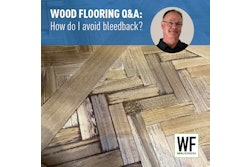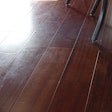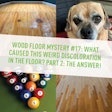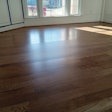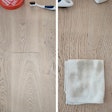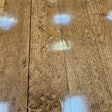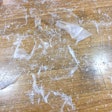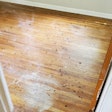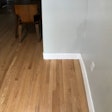I generally like writing for this blog when inspirations strikes or I would like bring something important to light. Today I want to talk about the HUGE elephant in the room: White Line Syndrome. The first reveal of white lines syndrome appeared back around 2008, and Hardwood Floors wrote about this topic back in 2011. Talks with my contractor buddies since then still have shown that some of these contractors are still concerned and distraught about white lines.
Over the years I have applied hundreds of thousands of square footage of each of the predominant finish systems on the market (waterborne, OMU poly, and conversion varnish). I have gotten the finish on my hands, applicators, you name it. Once you start touching the film layers of the various finishes by peeling them off varying surfaces like your hands or tailgate of your truck, you begin to notice something: They all have varying degrees of elasticity, adhesion and hardness. These three attributes of the various finishes are in direct correlation to their synergistic behavior with wood floors that experience seasonal movement.
Let's all agree to a couple things that the manufacturers may not like to hear but contractors all know is true:
- Wood floor finishes, within their inherit chemistry at the time of manufacturing, can be a culprit for white lines and are not always a contractor error.
- When coatings lose elasticity, they are a poor fit for the seasonal movement of wood flooring.
- One contractor in Kansas City went bankrupt and shut his business over the problem. He had a problem with white lines on over 100,000 square feet of floors in custom homes. He re-sanded the floors, and the problem re-developed. He is out of business now.
- I talked with a contractor in Texas who also had white lines claims that totaled over $130K. That contractor and I talked on the phone about the issue and why it happened. Later, a finish rep I know also told me he was trying to help work through the issue with this same contractor even though I had not mentioned this Texas contractor to the rep.
- WLS needs to be universally accepted as being a problem of incompatibility of certain finish systems with certain wood flooring species and installation scenarios. Once accepted, then all manufacturers of products that know of white lines claims need to specifically acknowledge the probability of this problem and train contractors accordingly. Simply sweeping the finish issue under the rug as a contractor error will not improve the industry as a whole.
- Architects and Builders have NO business specifying wood floor finishes on a project, PERIOD! My colleague who contacted me a week ago about a white lines problem mentioned that the architect specified a certain waterborne over wide-plank solid walnut in a radiant heat application. It resulted in an EPIC FAILURE! Architects are just an ancillary element in creating a beautiful wood floor and need to understand that. Because VOC was an issue in this project, I believe the architect should have specified something such as a hardwax oil, which will not result in WLS.
- Floor failures due to white lines are far more detrimental to the environment than the higher VOC of finish systems such as conversion varnish or tung oil, which do not exhibit this problem. If VOC really matters, then a contractor needs to step into hardwax oils or finish systems that have no known white lines issues. Secondarily, the contractors in this industry need to advise the homeowners and architects accordingly. If homeowners keep pushing that you to use a system that almost certainly guarantees a white lines issue, then contractors need to walk away.
- Stop pointing to stains as the contributor to white lines. Many of the calls I have received were natural finishes on woods such as tigerwood, walnut, and Brazilian cherry, which precludes stain from being the cause.
- Stacking too many finish coats in a short period of time. Solvents trapped within a coating can create many issues such poor adhesion to the wood, which appears as a white lines issue. For example, contractors who apply a system with stain and four coats of OMU poly within a two-day period are just risking a problem. Either contractors need to plan the schedule accordingly or use a different finish. These issues are not a manufacturer issue, but a user error.
- Waterborne finishes are a great product, but they all will not succeed in EVERY scenario, so don't let your finish sales rep brainwash you into believing it. The job of a wood floor professional is to be the utmost authority on any project. You are the guardian of your homeowner and their floor.
- Adhesion loss of a finish is NOT a manufacturer issue if you are using a dull abrasive or improperly abrading the floor. I see contractors push abrasives way too far, and when you touch the floor after they buff, it feels like polished glass. Finishes that require a mechanical bond will not stick, even though you are "going through the motions." Peeling at the edges of board seams from seasonal movement is an adhesion loss and not a finish failure. Don't blame the finish manufacturer.
- DO NOT mix finish systems. You may like stain from one company and the finish from a different company. The minute you mix the two, you gain ownership of the problem (in most cases). This is because the manufacturer only has the time and budget to test their own product combinations for success. The myriad competitor finishes and stain combinations are simply too exhaustive to test for most manufacturers.

















